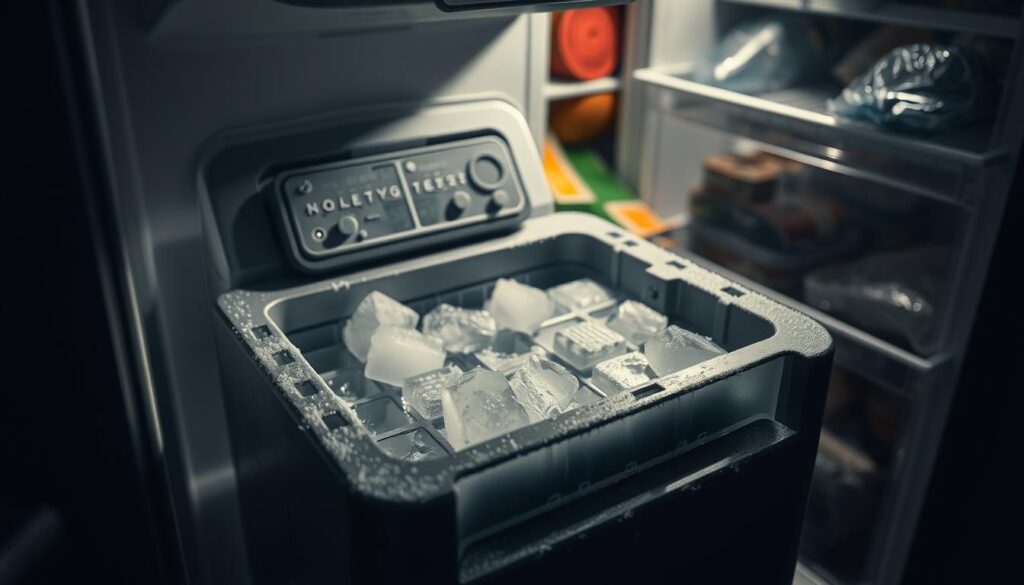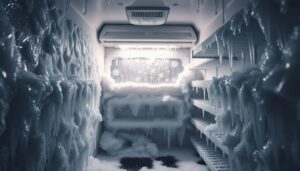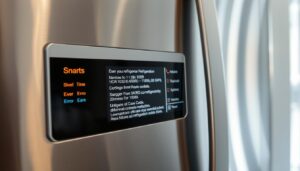Are you tired of waiting for what feels like an eternity for your ice maker to produce a batch of ice? You’re not alone. A slow ice maker can be a significant inconvenience, especially when you’re hosting guests or need a cold drink quickly.
The good news is that this issue is often easily resolvable. You might be wondering if it’s a sign of a more significant problem, but in most cases, it’s a simple fix.
We’ll explore the common causes and practical solutions to get your ice maker working efficiently again. From checking the freezer temperature to inspecting water supply issues, we’ll guide you through the troubleshooting process.
Key Takeaways
- Identify whether your ice maker is truly underperforming.
- Learn how to troubleshoot common issues affecting ice production.
- Understand the importance of regular maintenance and cleaning.
- Discover when to call a professional for assistance.
- Optimise your freezer’s usage for better ice production.
Understanding Your Ice Maker
Before diagnosing a slow ice maker, you need to know how it functions. Your refrigerator’s ice maker is a complex appliance that relies on several components working together to produce ice.
How Does an Ice Maker Work?
An ice maker works by using a refrigeration cycle to cool water to its freezing point, forming ice cubes. The process involves a series of steps, including filling a mould with water, freezing the water, and then harvesting the ice into a storage bin. The ice production rate depends on factors like the refrigerator model and the type of ice maker installed.
Normal Ice Production Rates
A typical ice maker should produce more than 80 ice cubes per day, with some models producing up to 140. Production cycles vary, with some models making 8-10 cubes every 90 minutes, while others take 3-4 hours. Key factors affecting ice production include freezer temperature, water pressure, and ambient room temperature. Here are some key points to consider:
- Most standard refrigerator ice makers produce between 80-140 ice cubes per day.
- Production rates are influenced by the specific refrigerator model and ice maker type.
- Your refrigerator’s manual should specify the expected ice production rate.
Common Reasons Why Your Ice Maker Is Slow
Several factors can contribute to a slow ice maker, including issues with temperature, water supply, and maintenance. Understanding these factors can help you identify and potentially fix the problem.
Temperature Issues
Temperature plays a crucial role in the functioning of your ice maker. If the freezer temperature is not set correctly, it can affect ice production. Ensure that your freezer is at the optimal temperature for ice making.
Water Supply Problems
Issues with the water supply can also impact your maker‘s performance. A clogged water filter or low water pressure can restrict water flow, slowing down ice production. Regularly check and replace the filter in your refrigerator to maintain optimal performance.
Maintenance and Cleanliness Factors
Over time, mineral deposits and debris can accumulate in the ice mold and water lines, hindering the ice maker‘s efficiency. Regular cleaning and maintenance are essential to prevent this buildup and ensure your maker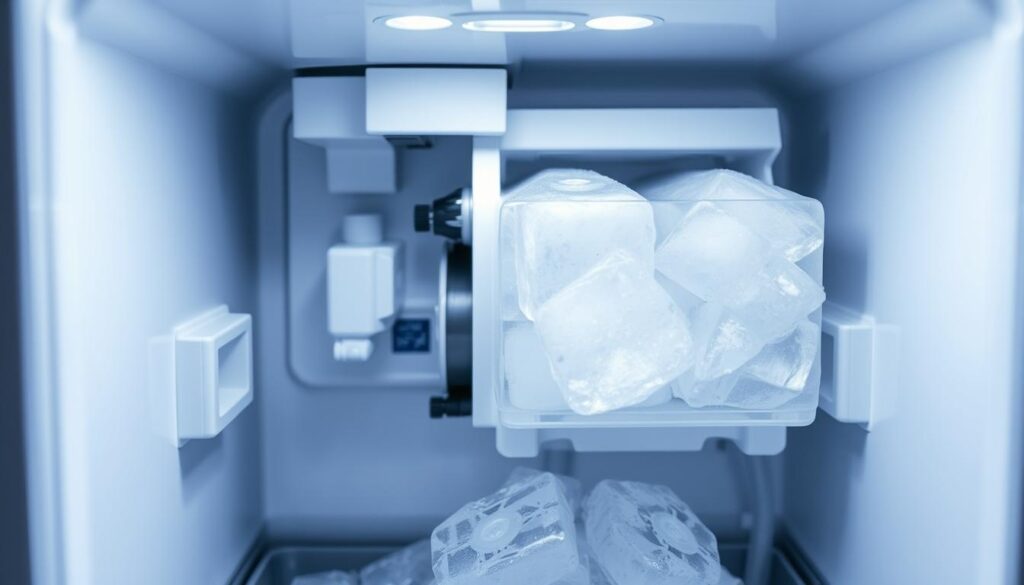
Check Your Freezer Temperature
If your ice maker is slow, one of the first things to check is the temperature setting of your freezer. Make sure it is set correctly, as this directly impacts ice production.
Optimal Temperature Settings
The ideal temperature for your freezer is 0 degrees Fahrenheit (-18 degrees Celsius). If the temperature is too high or too low, it can affect the ice maker’s performance. To ensure optimal ice production, verify that your freezer is at this temperature.
How to Adjust Your Freezer Temperature
To adjust the temperature, locate the control panel, which may be a dial, digital display, or buttons. For digital displays, press the adjustment buttons until you reach 0°F (-18°C). For dial controls, consult your owner’s manual, as numbering systems vary. After adjusting, wait 24 hours before evaluating ice production. Use a separate temperature thermometer to verify the actual temperature, as built-in displays may not be accurate.
Inspect the Water Supply System
To troubleshoot your slow ice maker, inspecting the water supply system is a crucial step. The ice maker’s performance is heavily reliant on the water supply system, which includes the water inlet valve, water lines, and supply valve.
Examining Water Pressure
The water inlet valve requires a minimum water pressure of typically 20 psi to function properly. You should check the water supply valve is fully open by turning it counterclockwise until it stops. Low water pressure can significantly impact the ice maker’s performance.
Checking for Kinks or Blockages in Water Lines
Inspect the water lines for any kinks or blockages that could restrict water flow. Mineral deposits can accumulate in the valve over time, particularly in areas with hard water, restricting or blocking flow. Ensure that the water lines are not damaged or frozen.
Testing the Water Inlet Valve
Listen for a clicking sound followed by water flow when the ice maker begins a cycle. If you don’t hear the clicking sound or water flow, it could indicate a faulty water inlet valve. You can test the valve with a multimeter to check for electrical continuity. A humming sound when the ice maker tries to fill but no water flows often indicates a faulty inlet valve.
| Component | Potential Issue | Solution |
|---|---|---|
| Water Inlet Valve | Defective or blocked | Replace or clean the valve |
| Water Lines | Kinks or blockages | Inspect and repair or replace lines |
| Water Supply Valve | Not fully open | Turn counterclockwise until it stops |
A faulty water inlet valve is a common cause of slow ice production. Replacing it with a model-specific valve can resolve the issue.
Replace Your Water Filter
A clogged water filter can significantly slow down your ice maker’s performance, so replacement is key. To maintain optimal ice production, it’s crucial to replace the water filter every six months.
Signs of a Clogged Filter
If your ice maker’s performance has decreased, it might be due to a clogged filter. Common signs include reduced water flow and slower ice production.
Step-by-Step Filter Replacement Guide
To replace your refrigerator’s water filter, first locate it—common positions include the upper right corner of the refrigerator interior, the base grille, or the back of the unit. Turn off the ice maker before beginning. For twist-in filters, rotate counterclockwise to remove and clockwise to install. For push-in filters, press the release button before removing. After installation, run 3-4 gallons of water through the dispenser to flush out air and carbon particles.
How to Fix a Slow Ice Maker in Freezer
A slow ice maker can be frustrating, but there are several methods to resolve the issue. To get your ice maker working efficiently again, you’ll need to identify and address the underlying problem.
Cleaning the Ice Maker Components
One common cause of a slow ice maker is dirty or clogged components. Cleaning the ice maker and its parts can help restore its function. Check for any visible signs of dirt or mineral buildup and clean accordingly. For more detailed guidance, you can refer to resources like this article on speeding up a slow ice maker.
Thawing a Frozen Water Line
If the water line is frozen, it can prevent the ice maker from receiving the water it needs to function properly. To thaw a frozen water line, turn off the freezer, and let it sit for a few hours. This should allow the ice to melt, restoring water flow to the ice maker.
Checking for Faulty Parts
Faulty parts, such as a malfunctioning thermostat or a blocked water inlet valve, can also cause issues with your ice maker. Inspect these components for any signs of damage or malfunction. Testing the water inlet valve with a multimeter can help determine if it’s functioning correctly. If you find any faulty parts, replacing them should resolve the problem with your ice maker.
Optimise Your Freezer Usage
To get the most out of your freezer, it’s essential to optimise its usage. A well-organised freezer can significantly enhance your ice maker’s efficiency.
Proper Food Storage Techniques
Store food in airtight containers to prevent moisture from affecting the ice maker’s performance. Ensure that frozen food packages are not overcrowding the freezer, allowing for adequate air circulation.
Reducing Door Opening Frequency
Minimise the frequency of opening your freezer door to maintain a consistent temperature. This helps your ice maker work more efficiently.
Keeping Items Away from the Ice Maker
Ensure that nothing is obstructing the ice maker or its bin. Keep the area around the ice maker clear to allow it to function properly.
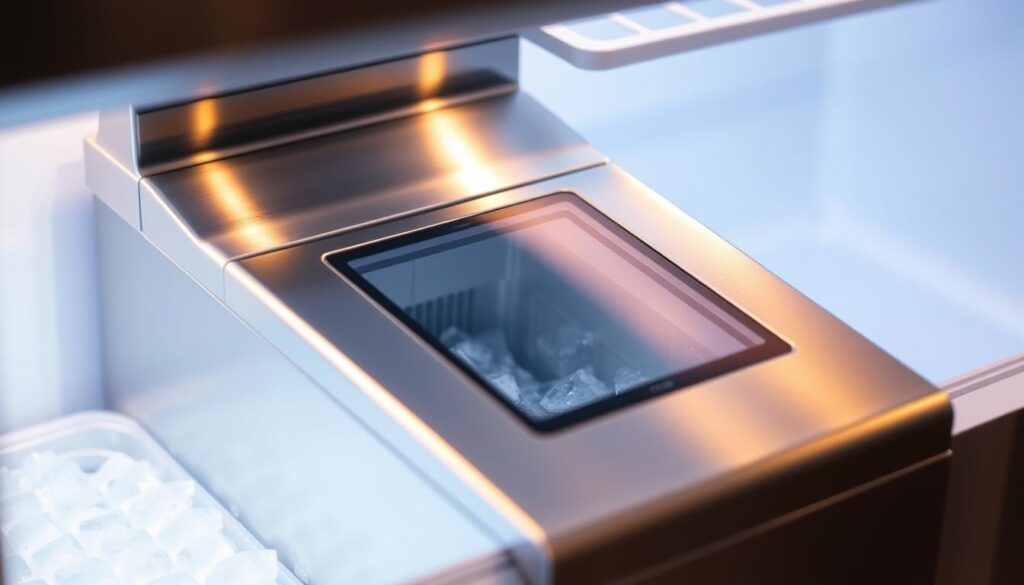
- Maintain a clear zone around the ice maker mechanism.
- Avoid stacking items against or on top of the ice maker assembly.
- Regularly inspect the ice maker area when adding or removing items.
When to Call a Professional
Should your ice maker continue to underperform despite your best efforts to rectify the issue, professional service may be necessary. If you’re unable to figure out why your ice maker is so slow, schedule service with a professional. They’ll quickly take care of your appliance and respect your home.
Signs of Serious Ice Maker Problems
If you notice persistent issues or signs of malfunction, such as unusual noises or leaks, it may indicate a serious problem with your refrigerator or ice maker. In such cases, seeking professional help is advisable to prevent further damage.
Finding a Qualified Appliance Repair Service
When looking for a repair service, consider the following:
- Look for services that specialise in refrigerator and ice maker repairs.
- Check for proper licensing, insurance, and manufacturer certifications.
- Read online reviews focusing on technicians’ expertise with your specific refrigerator brand and ice maker issues.
- Ask about warranty coverage for both parts and labour.
- Request an estimate before work begins and clarify diagnostic fees.
- Inquire about same-day service availability.
- Consider service contracts for newer, high-end refrigerators.
Conclusion
With a few simple checks and adjustments, you can restore your ice maker’s performance and enjoy a steady supply of ice. Regular maintenance, including temperature checks and filter replacements, can prevent most ice maker issues. Understanding your ice maker’s normal production rate helps you identify problems early. Most issues stem from temperature settings, water supply problems, or mechanical faults. By making simple adjustments to your freezer usage habits, you can significantly improve ice production. Proper care will ensure your ice maker provides years of reliable service.
